 Turkoman Figural Bronze Coins:
Turkoman Figural Bronze Coins:
A Supplement to Spengler and Sayles
Most early Islamic coins have designs that consist entirely of legends in Arabic without images. Turkoman figural bronze coins (c. AD 1150-1260) are different because they have images of humans and animals.
This page is about types that are not in the standard reference works by Spengler and Sayles (S&S):
Ayyubids, Seljuqs of Rûm (also spelled "Seljuks"), Danishmendids, and minor dynasties including the Begteginids (history) (called "Bektiginids" by Mitchiner), Begtimurids (history), Salduqids [also spelled Saltuqs, Saltuks], and Menkujakids.
A second page has Turkoman types that are in S&S.
A third page is about understanding the names and legends on Turkoman coins.
A fourth page is an annotated list of references.
Coin at the upper right: Ayyubid ruler Al-Awhad Ayyub Najm al-Din Ayyub, AD 1200-1210, with a facing bust. It is Ayyubid type 6 below. 26 mm and 8.56 grams.

To the right is a wikimedia map of the region c. 1200. It is far from precise. Region boundaries changed frequently.
A timeline of events is far below with another map of the region in 1200.
What's new? 2025, Oct. 22: A second SSS-Saltuqid 2 example.
2025, Oct. 21: A second SSS-Danishmendid 6 example.
2025, August 24: Saltuqid references to İzmirlier's 2024 book.
2025, June 4: Map to the right.
2025, June 1: SSS Saltuqid-1. Saltuqid reference work.
2025, April 24: SSS-Begtegnid 2.1 with bust right.
Turkoman. Turkoman figural bronze coins were issued c. AD 1150-1260—during the Crusades—in modern Asian Turkey and northern Syria (map below on this page). Turkoman (or Turkmen) is a generic term for Turkic tribes originally from Central Asia which converted to Islam and conquered much of the Middle East. Except for the Ayyubids, who were of Kurdish origin, all the dynasties with coins on this page traced their origin to Turkmen. However, they were no longer nomadic; nomads do not mint coins.
Artuqids and Zengids. All the figural bronzes of the Artuqids (a.k.a. Artukids or Urtukis) and Zengids (a.k.a. Zangids) are cataloged in the two volumes by Spengler and Sayles and are not discussed on this page. (However, some are on another page.) This site lists only the figural types that would have been in S&S volume 3, had it appeared. Types that consist entirely of legends are omitted.
Key
|
ID number. Diameter in mm.
ID number in the form "SSS <dynasty> type-number"
"SSS" for "Spengler and Sayles Supplement"
e.g. "SSS Ay-6" for type 6 of the Ayyubid dynasty
Image [Larger coins have larger images, but not in proportion.]
|
Ruler
[possible alternative spelling]
AH dates of the reign
AD dates
Obverse description
Reverse description
|
References
image source
(all images used with permission)
|
Note on spelling and names. Arabic has some sounds not found in English. Because English does not have letters for those sounds, many names in Arabic have been spelled more than one way in English. Sometimes when major references use different spellings, I have included both.
Also, names with full titulature are often long with numerous components, for example "Al-Ashraf Muzaffar al-Din Abu al-'Fath Musa ibn al-'Adil." Naturally we want to shorten this, but which components should be retained? I follow Album's Checklist. This name is rendered "al-Ashraf Musa." (More about names, titles, and dates.)
Ayyubids (Saladin and his successors) AH 564-c. 658, AD 1169-c.1260. The Ayyubids are rulers in the line of Saladin who is famous for winning the Battle of Hattin which was disasterous for the Crusaders. It lead to Jerusalem falling to the Muslims, which prompted the Third Crusade, during which Saladin was the chivalrous foe of Richard Lionheart. Technically, Saladin was a Kurd and not a Turk, but his dynasty also issued figural coins at the same time so they are included with "Turkoman" figural coins.
The Ayyubid types are in the order of Album's Checklist. An illustrated reference is The Coinage of the Ayyūbids by Paul Balog. Types that are not figural are omitted.
(Skip down to the Seljuqs, the Danishmendids, or the minor dynasties.)
Ayyubids
SSS Ay-1. 34-32 mm.

|
Sultanate of Egypt, Nisibin mint
al-Nasir I Salah al-Din Yusuf (Saladin)
AH 564-589, AD 1169-1193
Mint of Nisibin. Dated 578.
Facing bust in Sasanian-style crown.
4-line legend in square
Balog thinks the bust is Saladin himself. Others say: "Facing bust, female, with three-pointed crenelated crown," (A female bust is unlikely.) The obverse looks like the reverse of an Artuqid prototype, S&S 29, but the head is slightly larger and rounder and the other side is completely different.
Obverse inscription around: "struck in Nasabin year 578." ["Nasabin" may be spelled "Nisibin".]
To right: al-malik (the king)
To left: li-la (for God)
Reverse inscription in the square: "al-Malik al-Nasir Salah al-Dunya wa 'l-Din Abu l-Muzaffar." This is Saladin's title. "The Victorious King, the Righteous of this World and the Faith the Father of 'l-Muzaffar. Al-Muzaffar" (one of his 17 sons).
The inscription around the square (largely obliterated) is Saladin's actual name and further title "Yusuf b. Ayyub Muhyi Dawlat Amir al-Mu'minin" or Joseph the son of Job the Revivifier of the Dynasty of the Commander of the Faithful." |
Album 791.1 "R"
Balog 172-174, IX "578"
Image courtesy of CNG 94 lot 1597 |
|
SSS Ay-2. 30-27 mm.
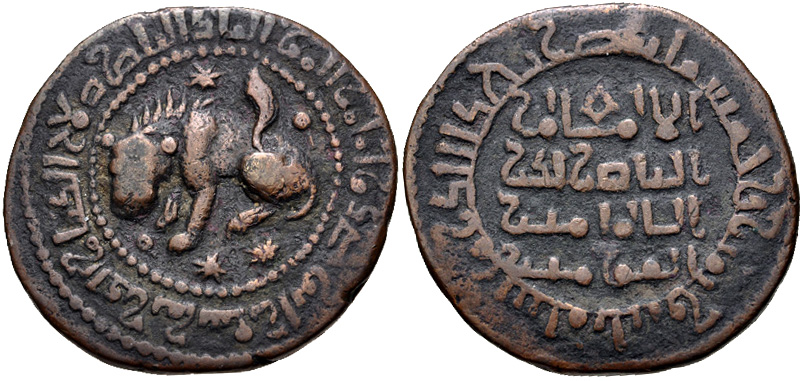

|
Sultanate of Egypt
al-Nasir I Salah al-Din Yusuf (Saladin)
AH 564-589, AD 1169-1193
No mint given, perhaps Harran. Mesopotamian style.
Dated 582
lion seated left in circle, legend around
"Constellation of the lion [Leo]"
4-line legend in circle, legend around
Name and titles of al-Nasir I Salah al-Din Yusuf in outer margin / Name and title of Abbasid caliph in four lines; mint formula and AH date 582 or 583 (1214/5 or 1215/6) in outer margin.
Obverse legend: al-Malik al-Nasir Salah al-Dunya wa ‘l-Din Yusuf b. Ayyub Muhyi dawlat Amir al-Mu’minin [Saladin . . . restorer of the state of the Commander of the Faithful]
Reverse central legend: al-Imam al-Nasir li-din Allah Amir al-Mu’minin [the caliph]
Encircling inscription: This dirham [sic] was struck in the year 582. |
Album 791.3 "S"
Balog 177, page 102, IX and X.
Whelan type II, 256-7
Mitchiner 814
Wilkes 896
Images courtesy of CNG 433 lot 519
and PC1 |
SSS Ay-3. 30-28 mm.

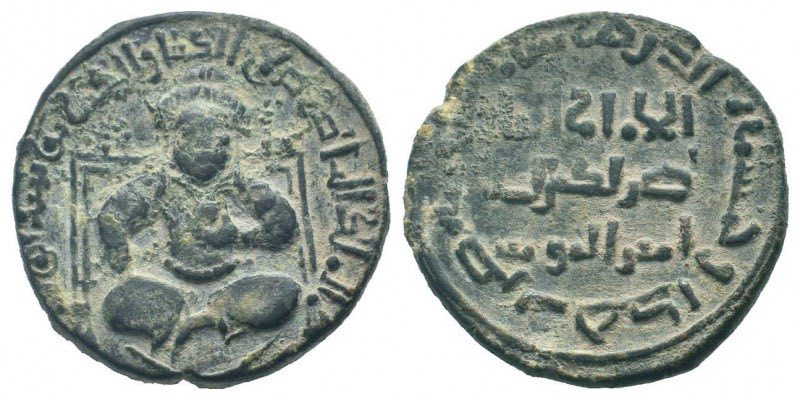
|
Sultanate of Egypt
al-Nasir I Salah al-Din Yusuf (Saladin)
AH 564-589, AD 1169-1193
No mint given, Mesopotamian style. Dated 586.
Figure seated cross-legged, with chair back, holding orb, legend around
Reverse: Central 3-line inscription with inscription around
(Although different stylistically, the two coins illustrated 3 actually have the same inscriptions. Be careful--S&S 46 has a similar obverse but the reverse inscription is quite different.)
Obverse: Turbaned sultan facing, seated cross-legged on a low square-backed throne surmounted by two pinnacles at the upper corners, wearing a turban, left hand holding an orb and right hand resting on his thigh
Inscription around from 5:00 to 7:00:
al-Malik al-Nasir Salah (al-dunya wa’l-din) Yusuf ibn Ayyub
“the Victorious King, Righteousness of the World and the Faith, Yusuf ibn Ayyub”
Reverse central inscription: al-imam al-na / sir li-din allah / amir al-mu’minin
with curved ornaments above and below
“the Imam al-Nasir li-Din Allah, Commander of the Faithful” [the calif]
Inscription around: duriba hadha’l-dirham sana sitt wa thamanin khamsmi‘a
“This dirham [sic] was struck the year six and eighty and five hundred”
[See also DC]
|
Album 791.4 "S" date "586"
791.5 is similar but lighter.
Balog 182, X.
Mitchiner 815.
Images courtesy of CNG 97, lot 824
and PC 1
|
SSS Ay-3B. 21 mm.
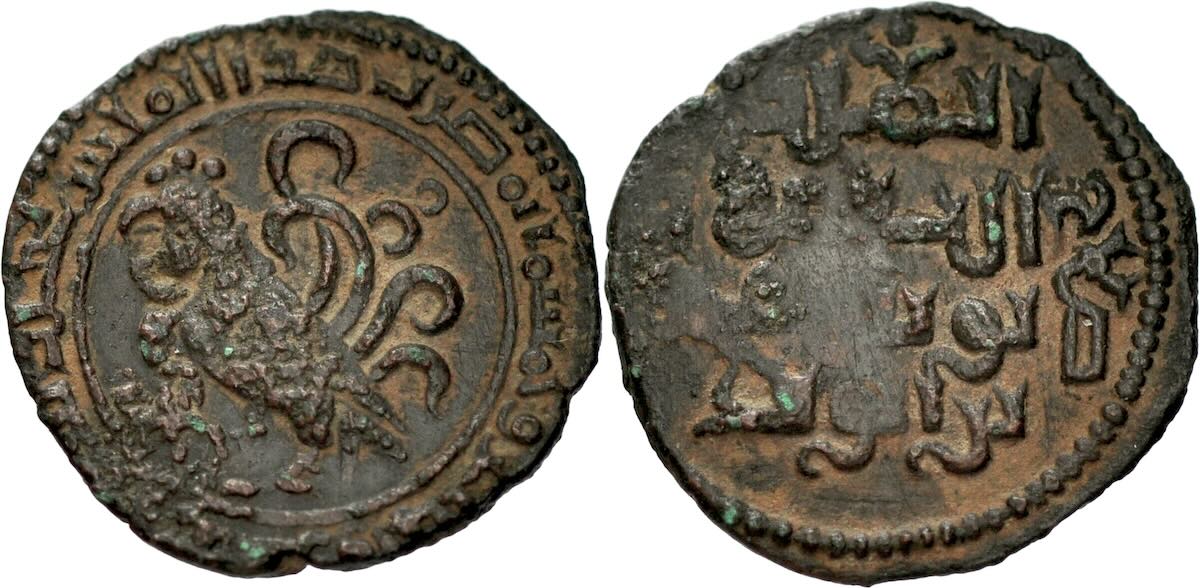
|
Ayyubids (Main line in Cairo).
al-Nasir I Salah al-Din Yusuf (Saladin).
AH 564-589 / AD 1169-1193.
Halab mint.
Dated AH 58x. Bird [Rooster].
Legend.
Balog, Ayyubids —; Album 792.
Extremely rare, apparently unpublished.
[This identification is from CNG]
|
Album 792 is not this specific type, but a catchall for related types. "RR"
Balog --
Image courtesy of CNG Islamic auction 5, session 2, 2024 April 19, lot 465 |
SSS Ay-4. 30 mm-27 mm.



|
Sultanate of Egypt, Cairo
Al-'Adil Abu Bakr I (brother of Saladin)
(sometimes spelled "al-Aadil I")
AH 589-596, AD 1193-1200
Mint of Mayafariqin.
Dated AH591-608
Bust, half-length, facing, headdress, cloak with three folds, looks like a tie, in circle, legend around
5-line legend plus four outside
[This type is very similar to SSS Ay 6 below. The reverse bottom, right, and top lines are much different.]
Top coin: Balog 340. To the right of the head, sana ahad (year one); to the left of the head (wa) tis'in khma (abbreviation for khamsa mi'a, 500), in other words (and) 90 500 or 591.
Second coin: Balog 338. To the right of the head, duriba sana (struck in the year); to the left of the head, ahad (wa) tis'in (one [and] ninety), or struck in the year 91, that is 591.
Bottom coin. Balog 337. To the right of the head: wa tis'in (and 90); to the left of the head: khamsa mi'a (500). The inscription around the head, counter clockwise reads: This dirham was struck in Mayafariqin year one--and then the rest of the date is to each side of the head. So the date is 591. All three coins have the same date, but the date is broken up differently in each case.
Reverse of Balog 340 and 337 (top and bottom coins): Counterclockwise around the center: al-Malik al-Adil Sayf al-Din Abu Bakr ibn Ayyub; in the center: there is no god but God, Muhammad is the messenger of God, al-Imam al-Nasir li-Din Allah Amir al-Mu'minin
Reverse of Balog 338 (middle coin). To the right of the central legend the word "duriba" (struck), to the left "in Mayafariqin." At the top is some kind of decorative feature, not a word. The central inscription reads: There is no god but God alone, he has no partner, al-Imam al-Nasir li-Din Allah Amir al-Mu'minin.
|
Album 809 "C"
Balog 337-343
Whelan Type I, 264-5
"591-608"
Mitchiner 824
Images courtesy of CNG 68 lot 1656
and two from PC1 |
SSS Ay-5. 24 mm. 22 mm.


|
Principality of Hamah
Al-Mansur Muhammad I
(son of Saladin's favorite nephew. He inherited Hamah in 587)
AH 587-617, AD 1191-1220
Mint of Harran. Dated 587 or 589.
Seated figure, cross-legged, holding crescent, in circle, legend around
al-Mansur . . .
3-line legend in square
(Name and title of Saladin)
Central inscription: al-Malik al-Nasir Salah al-Din Yusuf b. Ayyub
Surrounding inscription: Struck in Harran in the year 587 |
Album 851 "RR"
Balog 832
Images courtesy of CNG 347 lot 615
and PC1
|
SSS Ay-6. 26 mm.
 |
Mesopotamian Ayyubids
(Principality in the Jazirah)
Al-Awhad Ayyub (Najm al-Din)
AH 596-607, AD 1200-1210
Mint of Mayafariqin. Dated 599, 601, 602, or 605.
Bust, half-length, facing, headdress, cloak with three folds,
looks like a tie, in circle, legend around
[This type is very similar to SSS Ay-4 above. The reverse bottom, right, and top lines are much different.]
5-line legend plus four outside
Obverse: Plain circle in which is a facing bust of the prince, covered by a bonnet. Hair hangs from temples. He wears a mantle, held together in front by a clasp, from which a pendant hangs down.
Inscription to right and left of head: al-Malik al-Awhad
Inscription around: This dirham [sic] was struck in Mayyafariqin in the year 601 [this coin]
Reverse: central inscription in shape of square with second inscription around three sides all within a lineal circle within a circle of dots
Central inscription: There is no god but God, Muhammad is the messenger of God, al-Imam al-Nasir li-din Allah Amir al-Mu’minin [the caliph, 575-622/1180-1225]
Surrounding inscription: Sayf al-Din Abu Bakr b. Ayyub al-Malik al-Adil
|
Album 856.1 "C"
Balog 841-844
Mitchiner 864, 865
[Do not confuse this with SSS Ay-4]
Image courtesy of PC 1
|
SSS Ay-7. 28 mm.
 |
Ayyubid branch at Mayyfariqin and Sinjar
Al-Awhad Ayyub (Najm al-Din)
AH 596-607, AD 1200-1210
Mint of Mayafariqin(?). Dated 605
Bust, half-length, facing, cloak with three folds gathered at the center with the left hand.
Hexagram, legend inside and outside
Obverse: Facing bust of turbaned prince, earrings or pendants hanging. Cloak around shoulders, gathered in the center with left hand. Head is flanked by short, counterclockwise legend. "The year 605"
Legend around: al-Malik al-Awhad Najm al-Dunya wa ‘l-Din Shah Arman Abu ‘l-Fath b. Malik al-Adil
Reverse: linear six-pointed star
Central inscription: There is no god but God, Muhammad is the messenger of God
Legend in the points of the stars: Allah Amir al-Mu’ (sic) al-Imam al-Nasir li-Din [the caliph, 575-622/1180-1225]
Legend between the points: Sayf al-Din Abu Bakr b. Ayyub al-Malik al-Adil
|
Album 856.2 "C"
Balog 845
Struck "605"
Wilkes 941
Image courtesy of PC 1
|
SSS Ay-8. 30 mm.
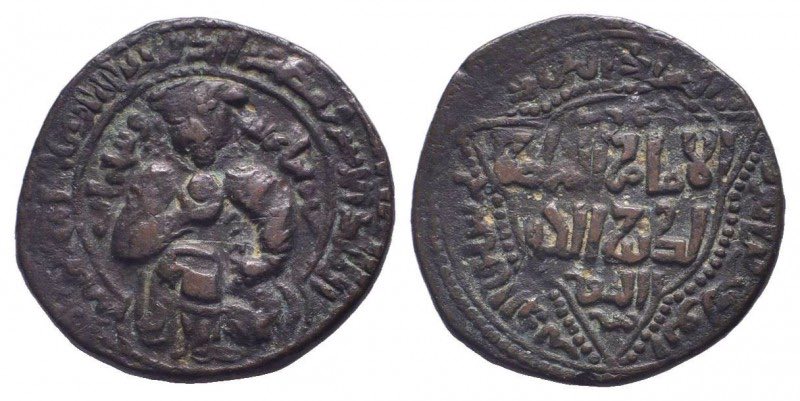
 |
Ayyubid branch at Mayyfariqin and Sinjar
Al-Ashraf Musa
Muzaffer al-din ibn al-'Adil
AH 607-617, AD 1210-1220
Mint of Mayafariqin. Dated 608 or 612 [this coin is 612].
Turbaned prince, seated facing, right leg drawn up, orb in right hand, in circle, legend around:
al-Malik al-Ashraf Muzaffar al-Din Shah Arman Abu ‘l-Fath Musa
Triangular shield (ornamented triangle) with convex side-centers, legends within and around. There are varieties with and without the title "Shah Arman" and overlord "al-Adil". On some varieties the overlord is al-Kamil who was al-Adil's brother and predecessor.
Inscription in shield: Minin al-Imam al-Nasir li-Din Allah Amir al-Mu’ [the caliph, 575-622/1180-1225]
Inscription around the shield: al-Malik al-'Adil Sayf al-Din Abu Bakr b. Ayyub |
Album 859.1 "C"
Balog 848-852, page 256, XLIIf
Struck "612"
Mitchiner 866-7.
Images courtesy of PC 1
|
SSS Ay-9. 25-26 mm.

 |
Ayyubid branch at Sinjar
Al-Ashraf Musa
Muzaffer al-din ibn al-'Adil
AH 607-617, AD 1210-1220
Mint of Singar. Dated 615, 617.
Turbaned prince, seated facing with legs drawn up, orb in left (sometimes right) hand, in circle, legend around.
4-line legend, more outside
Obverse: Prince sits facing with legs drawn in, oriental fashion. Turbaned head and halo of minute dots around head. Left hand holds orb, the right rests on his lap. Short legend to left and right of head, "The year 61x" [top coin uncertain, second coin is 615]
Inscription around: al-Malik al-Ashraf Shah Arman Musa b.
Abi Bakr
Reverse central inscription: al-Imam al-Nasir li-Din Allah Amir al-Mu’minin [the caliph, 575-622/1180-1225], al-Malik al-Kamil
Inscription on the four sides: There is no god but God,
Muhammad is the messenger of God |
Album 859.2
Balog 853-5, XLIII
Whelan Type II, 275-6
Mitchiner 868
Images courtesy of PC 1
|
Skip to the Ayyubids, Danishmendids, or minor dynasties including the Begteginids, Begtimurids, Salduqids, and Menkujakids.
Seljuqs of Rûm. The entries are in the order of Album's Checklist. Illustrated references are A Survey of the Coinage of the Seljuqs of Rome by Broome and Novak and The Coins of Anatolian Seljuqs by İzmirlier and Paraları. A timeline and map are below. Types that are not figural are omitted.
Note on the legends (by Gary Leiser): Note I have given the spelling according to the transliteration of the Arabic alphabet, thus Qilij instead of the Turkish Kilich. Turkish has no q sound and Arabic has no ch.
Notes for collectors. Many Seljuq types are hard to tell apart. Among the 27 "types" below, most are
1) horseman galloping right (occasionally left) with various weapons.
Others have a
2) Byzantine-emperor-style obverse (#1, #9, #10, #26) or
3) a facing seated-figure (#3, #7, #16, #17).
The horseman design is by far the most common. It comes in various sizes from very large (35 mm) to small (18 mm) and it comes with reverse legends with various numbers of lines including the name of the ruler (but I do not read Arabic--I rely on the classifications of Album and Broome). Types 5 and 14 have the horseman spearing an animal, which are somewhat different. I have chosen to treat similar varieties as belonging to one type if the varieties in Broome are of the same ruler, size, and general figural design, even if they have different dates or are from different mints, or have small variations in the pose or weaponry of the horseman.
Often the reverse legend has a few long main lines with very short lines above and below (sometimes up and down the sides, too, e.g SSS Sel-12.) Do we count the very short lines in the number of lines, or just the longer lines? I have chosen to say, for example, "3-line legend" even if there really are two short additional lines above and below the main three.
You may need to use the reverse legends (which are not given here) to distinguish similar types and that may require employing reference works with more illustrations than are given here.
Gary Leiser and Steve Album have been a great help with these Seljuq types. Gary transliterated and translated the legends. Gary also helped identify the types. Steve patiently answered many questions, helped me decide what to include as types, and provided some of the images.
(Skip down to the Danishmendids or the minor dynasties. Return to the Ayyubid types above. )
Seljuqs (Seljuks) of Rûm
SSS Sel-1. 21 mm. (First coin 21 mm. Second coin, 24-22 mm.)


|
Mas'ud I
(Rukn al-din Mas'ud I b. Qilich Arslan)
AH 510-551
AD 1116-1156
Facing half-length figure of Byzantine emperor, holding globus cruciger right or left
Arabic 4-line legend
[The first Seljuq type. Obverses resemble tetartera of Alexius I (1081-1118) or Manuel I (1143-1180)]
Reverse legend: Al-Sultan al-Mu’azzam Mas’ud b. Qilij Arslan
"The August Sultan Mas’ud b. Qilij Arslan"
|
Album 1192 "R"
Broome 1
Wilkes 1318
Images courtesy of PC 1
|
SSS Sel-2. 21-18 mm.
 |
Qilich Arslan II (at Sivas)
AH 551-588
AD 1156-1192
Horsemen galloping right (sometimes to the left) with leveled lance
4-line legend
|
|
| SSS Sel-3 has been removed. This number was given to Mitchiner 955, which I now know to have been misattributed. His 955 is really SSS Sel-17. |
|
|
SSS Sel-4. (Small)

|
Malikshah II
(Qutb ad-din Malikshah II b. Qilij Arslan II) (Abū al-'Fath)
(at Sivas and Aksaray)
AH 499. AD 1105
Horseman right, being crowned by angel from behind
3-line legend
Abu ‘l-Fath Malikshah b. Qilij Arslan
"The Conqueror Malikshah son of Qilij Arslan"
|
Album 1195 "RR"-
Broome --
Image courtesy of Album, 33, lot 597 |
SSS Sel-5. 32-27 mm.
 |
Malik Qaysarshah
(Qaysarshah b. Qilij Arslan II)
AH 580s?
AD 1180s?
facing horseman right with lance, spearing coiled dragon [very weak on this example]
[Somewhat resembles Sel-15 below]
3-line legend
Al-Malik al-Mu’ayyad Qaysarshah b. Qililj Arslan
"The Supporting King Qaysarshah son of Qilij Arslan" (Presumably this means he was supportive of the Seljuk sultan)
|
Album 1196 "RR"
Broome 38A
Mitchiner 959
Image courtesy of Album Horizon Auction 1, lot 432
|
SSS Sel-6. 24 mm.
 |
Tughril [Toghril]
(Tughril b. Qilij Arslan II) at Ezurum
AH c. 580s - 618
AD c. 1180s - 1221
Horseman to right with mace over right shoulder
4-line legend
Mughith al-dunya wa’l-din abu ’l-fath tughril bin qilij arslan. “Helper of the World and Relgion,” Abu ’l-Fath Tughril, son of Qilij Arslan |
Album 1199.1 "R"
Broome 107
Image courtesy of PC 1
|
SSS Sel-7. 25-22 mm.
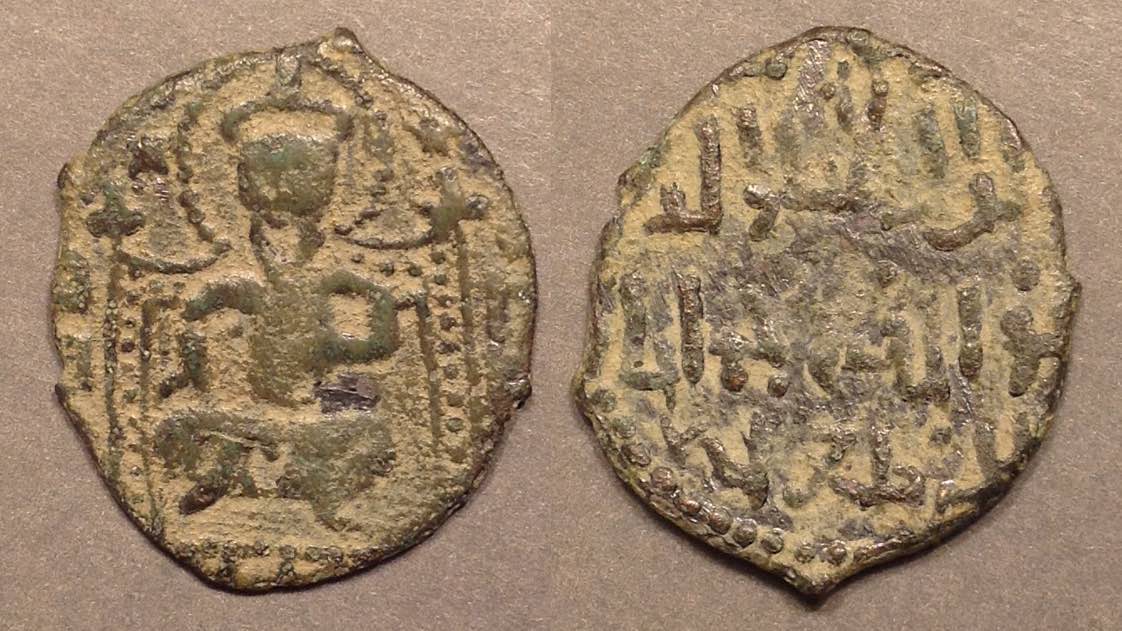
Sel-3, 7, 10, 16, and 17 are similar.
|
Jahanshah b. Tughril
(Rukn al-Din Jahanshah b. Toghril)
at Erzurum
AH 620s. AD 1220s
Dated 625
Seated figure, cross-legged, on high-backed throne with scooped back. His left hand is on his chest.
3-line legend
Reverse legend: Rukn al-Dunya wa’l-Din Abu ‘l-Fath Jihan b. Tughril
"The Pillar of this World and the Faith, the Conqueror Jihan son of Tughril" |
Album 1200 "RR"
Broome 109
Mitchiner 961
Photo courtesy of PC 1. |
SSS Sel-8. 21-19 mm.
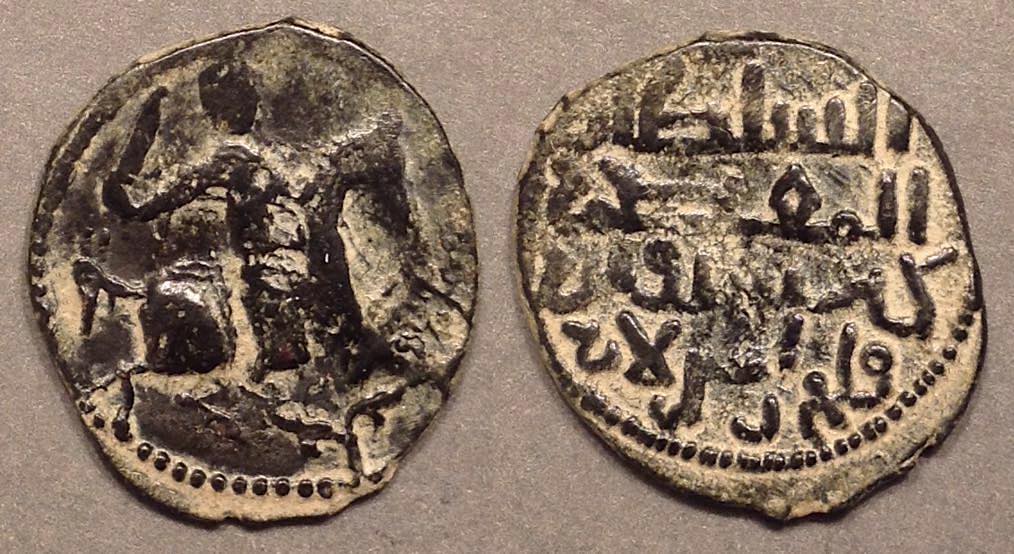 |
Kay Khusraw I, first reign
(Ghiyath al-din Kay Khusraw I b. Qilich Arslan)
AH 588-593. AD 1192-1197
(Second reign below)
AH 600-607. AD 1204-1210
Horseman right, brandishing sword. No obv. legend.
Sel 14 is similar but with an obverse legend.
4-line reverse legend
Revesre legend: Al-Sultan al-Mu’azzam Kaykhusraw b. Qilij Arslan
"The August Sultan Kaykhusraw son of Qilij Arslan" |
Sel 8.1 is Album 1202 "C" (first reign)
Broome 29
Mitchiner 957
Wilkes 1322 (no photo)
Images courtesy of PC 1. |
SSS Sel-9. (20-18 mm)

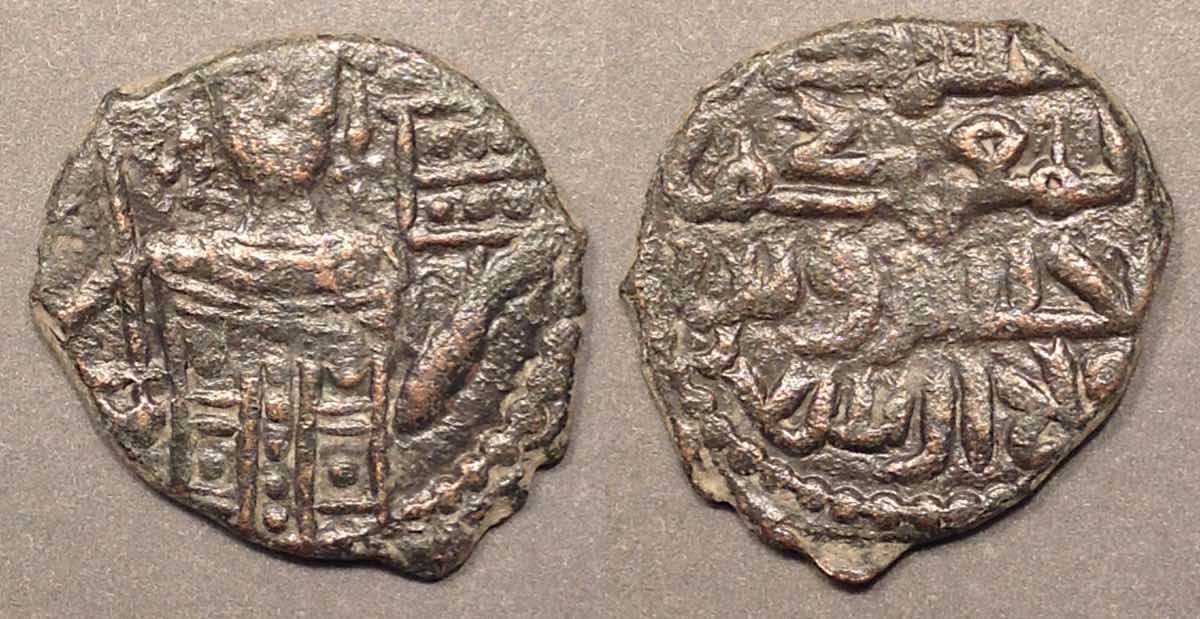 |
Kay Khusraw I, first reign
(Ghiyath al-din Kay Khusraw I b. Qilich Arslan)
AH 588-592. AD 1192-1196
Byzantine-emperor-style half-length figure facing.
4-line legend
A small imitation of the obverse of a follis of Manuel I Comnenus (1143-1180 AD/ 537-576 H) where the emperor is facing the viewer wearing imperial vestment.
Reverse legend: al-sultan / al-mu’azzam / kaykhusraw ibn (qilij arslan)
“The Mighty (August) Sultan Kaykhusraw ibn (Qilij Arslan)”
[See also DC.]
DC notes, "Qilij Arslan [this ruler] divided his lands among his ten sons, a brother and a nephew. This had the predictable, but unintended, result that all twelve of them fell to fighting one another." |
Album 1203 "RR"
Broome --
Wilkes 1323 (no photo)
Album 1203
Images courtesy of Album 37, lot 2265
and PC1
|
SSS Sel-10. (Small)
Full figure facing, seated on Byzantine throne. [No photo]
[How does this differ from SSS-Sel 7, 16, and 17?]
Sel-7, 10, 16, and 17 are similar. |
Kay Khusraw I, first reign
(Ghiyath al-din Kay Khusraw I b. Qilich Arslan)
AH 588-592. AD 1192-1196
Full figure facing, seated on Byzantine-style throne
Presumably the same inscription as Sel-9 above. |
Album 1203A "RR"
Is this Broome 327 and "MB"? |
SSS Sel-11. 30-27 mm.


|
Sulaymān II [Suleyman II, Suleiman]
(Rukn ad-Din Sulayman II b. Qilich Arslan), as malik at Tokat,
AH 582-595
AD 1186-1199
Horseman galloping right with mace over shoulder.
3-line legend, no legend around.
Reverse legend: Al-Malik al-Qahir, Sulaymanshah b. Qilij Arslan
"The Victorious King, Sulaymanshah son of Qilij Arslan" |
Album 1205.1 "S"
Broome 39B
Mitchiner 963-4
Images courtesy of PC1 and Roma Numismatics 45, lot 820.
|
SSS Sel-12. 35-25 mm. (Large, but of a range of sizes)
 |
Sulaymãn II [Suleyman II, Suleiman] as Sultan
(Rukn ad-Din Sulayman II b. Qilich Arslan)
AH 593-600. AD 1196-1204
Horseman nimbate, galloping right with mace over shoulder.
3-line legend, legend around
Central inscription, Al-Sultan al-Qahir, Sulayman b. Qilij Arslan
"The Victorious Sultan, Sulayman son of Qilij Arslan"
The encircling inscription: Duriba fi sana thaman tis’in wa khams mi’a
"Struck in the year 598"
|
Album 1205.2 "C", date "595"
Broome 57-61
Broome 62 is Wilkes 1327
Image courtesy of PC 1. |
SSS Sel-13. 23-18 mm. (23 mm. 22-21 mm.)


|
Kay Kayhusraw I, second reign
AH 600-607
AD 1204-1210
Horseman right (sometimes left), lance or mace or sword diagonally over left shoulder, Common with stars in fields (as here), but sometimes with a legend instead of stars.
[Cf. SSS Sel 8 above]
Rev: 4- or 5-line legend
Reverse legend: Al-Sultan al-Mu’azzam Kaykhusraw b. Qilij Arslan
"The August Sultan, Kaykhusraw son of Qilij Arslan" |
Album 1207
Broome 85, 92 (left), 93, 95, 97
(24 photos)
Wilkes -- (1322 is similar, but first reign and SSS Sel-8 above)
Images courtesy of PC 1. |
SSS Sel-14. 23-18 mm.
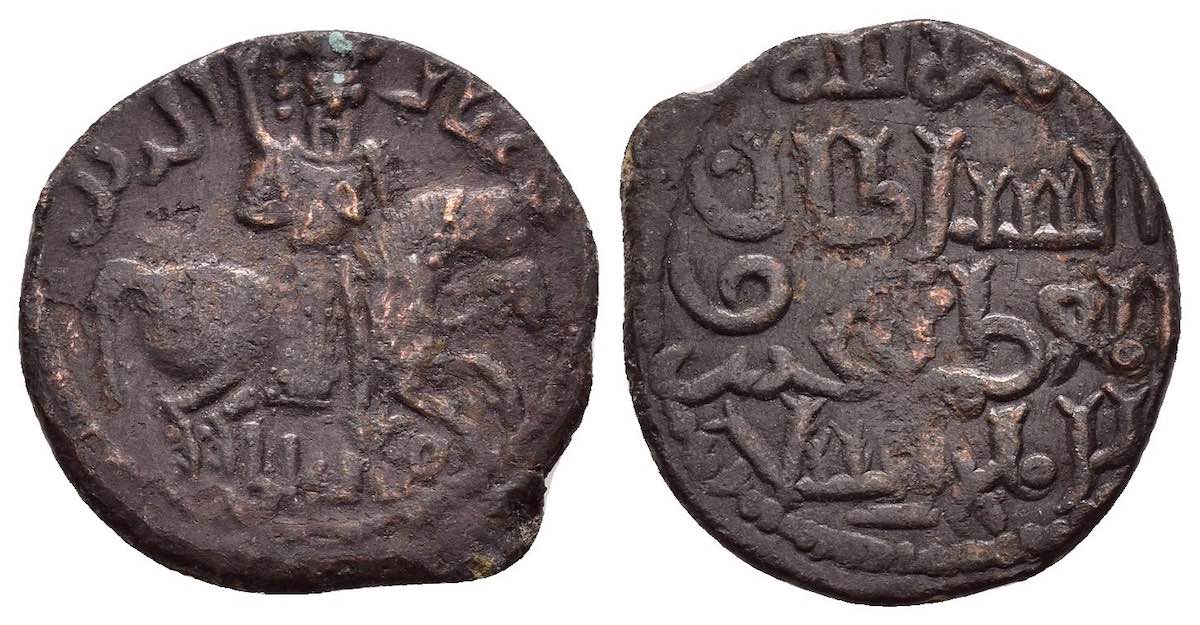

|
Kay Kayhusraw I, second reign
AH 600-607. AD 1204-1210.
Mint: Malatya
Horseman right, lance or mace or sword diagonally over right shoulder, with an obverse legend instead of stars like SSS Sel-8.
[Cf. SSS Sel 8 above]
Rev: 4- or 5-line legend
Obverse legend: Ghiyath al-Din, Malatya (the Sultan’s honorific title, "Helper or Supporter of the Faith", and the mint)
Reverse legend: Al-Minna li’llah, al-Sultan al-Mu’azzam Kaykhusraw b. Qilij Arslan
"Benevolence is from God, the August Sultan Kaykhusraw son of Qilij Arslan" |
Album 1210
(second reign)
Broome 93
Mitchiner 958
Image courtesy of PC 1. |
SSS Sel-15. 31-28 mm.
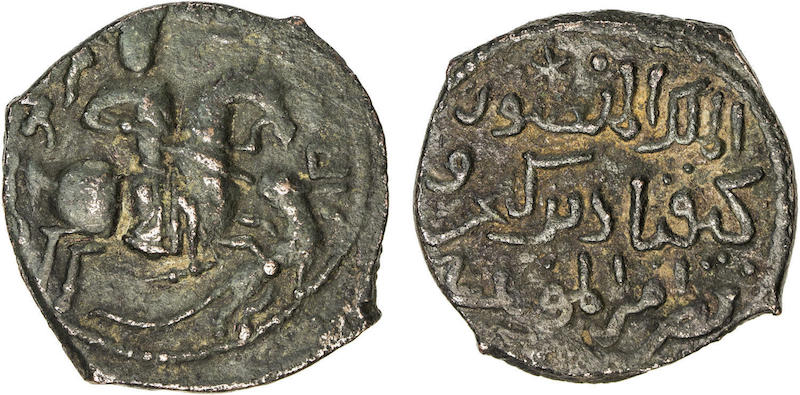
|
Kayqubād
[Kay Qubadh]
b. Kay Kayhusraw
[Kayqubad I] as malik of Tokat.
AH 607-610
AD 1210-1213
Horseman right, spearing animal with long tail (lion or panther) [Sometimes "St. George slaying a panther"]
3-line legend
[The large size and horseman resemble #5 above, but the animal is different].
Al-Malik al-Mansur Kayqubad b. Kaykhusraw Qasim Amir al-Mu’minin
"The Victorious King, Kayqubad b. Kaykhusraw the Partner of the Commander of the Faithful"
|
Album 1213A "RRR"
Broome 99
Wilkes 1332
Note: The old Album 1210 is now 1231G attributed to Kaykā’ūs II, 2nd sole reign.
Image courtesy of Album 33, lot 603. |
SSS Sel-16. (Small)
King seated on throne
[No photo]
Sel-7, 10, 16, and 17 are similar. |
The three brothers (Kaykā’ūs II, Qilij Arslān IV & ‘Alā al-Dīn Kayqubād II),
AH 647-657. AD 1249-1259
King seated on throne, short inscription
No photo, but no doubt the coin in Yilmaz Izmirlier’s The Coins of the Anatolian Seljuqs that reads (p. 239, nr. 606),
Al-Sultan al-A’zam Kaykawus wa Qilij Arslan Kayqubad b. Kaykhusraw (barahin) Amir al-Mu’minin
"The Most August Sultan Kaykawus and Qilij Arslan (and) Kayqubad b. Kaykhusraw (the Proofs of) the Commander of the Faithful"
|
Album 1228A "RRR"
Izmirlier-606/607 |
SSS Sel-17. 19 mm.


[How does this differ from SSS-Sel 7, 10, and 16?]
Sel-7, 10, and 16 are similar.
For many more examples, see
https://www.zeno.ru/showgallery.php?cat=19318
|
Kaykā'ūs II, 2nd sole reign
[Kay Khusraw II]
AH 655-660
AD 1257-1261
Enthroned emperor
3-line legend
al-Sultan al-A'zam 'Izz al-Dunya wa 'l-Din.
"The most August Sultan, the glory of this world and the faith." |
Album 1231G "R"
[Formerly Album 1210]
Izmirlier 1392
or First Reign,
Izmirlier 654-5
(Mitchiner 955, but misattributed there)
Images courtesy of PC 1.
|
SSS Sel-18. (Small)
Note: Types 17-23 are of Mas'ud II who apparently issued several rare figural types which are only recently becoming known. There may well be other rare types not in this table.

|
Mas'ud II
(b. Kaykā’ūs, [Ghyias] Ghiyath al-Dīn Abū ’l-Fath)
AH 679-697. AD 1280-1298
First reign, 1280-1284
Horseman right holding a bow and firing an arrow
Legend in hexagon.
Al-Sultan al-A’zam Ghiyath al-Dunya wa ‘l-Din Mas’ud
"The Most August Sultan the Helper of this World and the Faith Mas’ud"
|
Album A1235 "RRR"
Image courtesy of Album 37, lot 2281.
Izmirlier 1392
|
|
SSS Sel-19. Some are 23 mm. This one is only 18.5-15.5 mm.
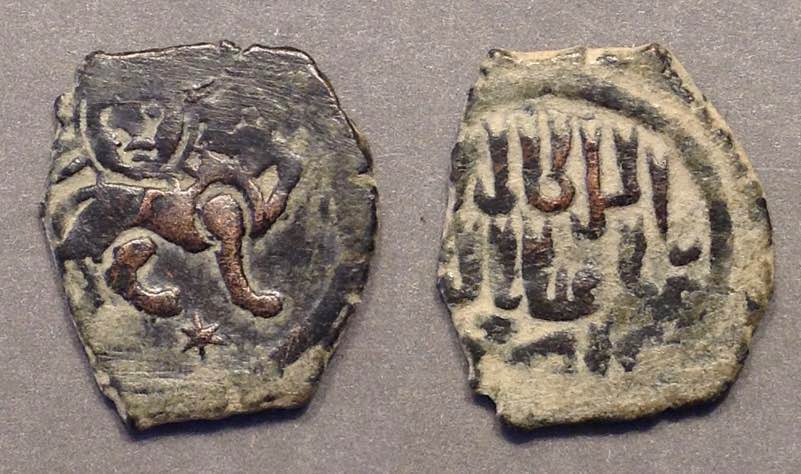
Another, larger:
https://www.zeno.ru/showphoto.php?photo=272523
|
Mas'ud II
(b. Kaykā’ūs, [Ghyias] Ghiyath al-Dīn Abū’l-Fath)
AH 679-697. AD 1280-1298
First reign, 1280-1284
Lion (right, sometimes left), sun face above
Reverse legend in circle or hexagon
Same inscription as Sel-18. |
Album A1235
Rare
Izmirlier 1388-1389
Image courtesy of PC1
|
SSS Sel-20. 22 mm.
Human face [Photo link]
https://www.zeno.ru/showphoto.php?photo=251793 |
Mas'ud II
(b. Kaykā’ūs, [Ghyias] Ghiyath al-Dīn Abū’l-Fath)
AH 679-697
AD 1280-1298
First reign, 1280-1284, at Sivas
Human face
Same inscription as Sel-18 but next to the face it says Duriba Siwas, "Struck (in) Sivas"
|
Album A1235
Very rare
Izmirlier 1384-1387 |
SSS Sel-21. 20 mm.
Sun face
[Photo link: https://www.zeno.ru/showphoto.php?photo=251792 ] |
Mas'ud II
(b. Kaykā’ūs, [Ghyias] Ghiyath al-Dīn Abū ’l-Fath)
AH 679-697. AD 1280-1298
First reign, 1280-1284, at Sivas
Sun face
Same inscription as Sel-20
|
Album A1235
Very rare
Izmirlier |
SSS Sel-22. 17 mm. (Small)
Bird (duck?) right
[Photo link: https://www.zeno.ru/showphoto.php?photo=252341]
(All of these are extremely crude. They have one or two six-pointed stars in the field.) |
Mas'ud II
(b. Kaykā’ūs, [Ghyias] Ghiyath al-Dīn Abū ’l-Fath)
AH 679-697. AD 1280-1298
First reign, 1280-1284, at Sivas
Bird right
Same inscription as Sel-18 but according to Izmirlier (p. 463, nr. 1391) there is a date around the circle containing the bird, apparently Duriba saba’ thamanin sittami’a, "Struck in 687." |
Album A1235
Very rare
Izmirlier 1391 |
SSS Sel-23.
Double-headed eagle
[No photo] |
Mas'ud II
(b. Kaykā’ūs, [Ghyias] Ghiyath al-Dīn Abū ’l-Fath)
AH 679-697. AD 1280-1298
First reign, 1280-1284, at Sivas
Double-headed eagle
Two versions in Izmirlier (p. 465, nrs.1393-4), one reads Al-Sultan al-A’zam Ghiyath al-Dunya wa ‘l-Din Mas’ud
"The Most August Sultan the Helper of this World and the Faith Mas’ud"
The other reads Al-Sultan al-A’zam Ghiyath al-Dunya wa ‘l-Din
"The Most August Sultan the Helper of this World and the Faith" |
Album A1235
Very rare
Izmirlier 1393-1394 |
SSS Sel-24.
Rabbit
[No photo] |
Mas'ud II
(b. Kaykā’ūs, [Ghyias] Ghiyath al-Dīn Abū ’l-Fath)
AH 679-697. AD 1280-1298
First reign, 1280-1284, at Sivas
Rabbit
No photo. But probably Al-Sultan al-A’zam Ghiyath al-Dunya wa ‘l-Din Mas’ud
"The Most August Sultan the Helper of this World and the Faith Mas’ud"
which appears on virtually all these crude copper coins. |
Album A1235
Very rare
|
SSS Sel 25. 22-20 mm. (Small)
Horseman left. [No photo] |
Uncertain.
"The ruler in the margin is probably the Western Seljuq Tughril III b. Arslan (AH 571-590), and the word in the center is uncertain, probably not Sulayman, possibly a crude version of Salduq ( سلدق ), perhaps a reference to Muhammad b. Salduq (563-587)." [Album]
Horseman galloping left, cross or battleax over shoulder
1-line legend in small circle, legend around |
Broome 39A, but probably not Rûm Seljuq, rather Western Seljuq, according to Steve Album.
No Album number. It is only tentatively attributed. |
SSS Sel-26.
 |
Standing figure, hatted, raising both arms in prayer, without cross, labarum & globus cruciger / same, but with star left & right of head, anepigraphic (no inscription)
"Although clearly a coin of Byzantine style, the lack of any Christian motifs and the position of the praying figure strongly suggest a Muslim origin, and the most likely might be the early Seljuqs of Rum, up to and including Mas'ud I (1116-1156), whose epigraphic issue retains the normal Christian figures (A-1192)." [Album 20, lot 291] |
Album --
Probably unpublished
Very rare
Image courtesy of Album 20, lot 391.
|
SSS Sel-27. 23 mm. 3.82 grams. (Second coin, 22-20 mm.)
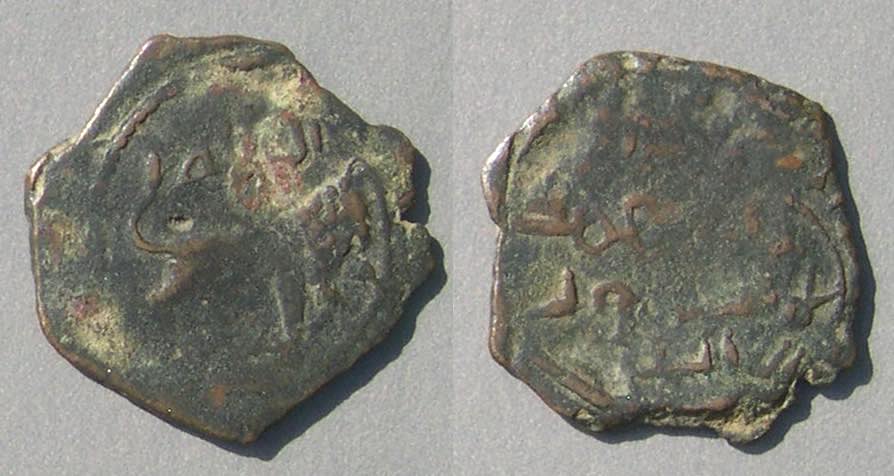
 |
Seljuqs of Syria
Anonymous
c. AH 480-AH 510/1117 when the Burids took over.
Struck at Antakiya (Antioch)
Lion right
Legend
Gary Leiser notes, "Below the lion it looks like ahad wa . . . one and . . . So this would be part of the date.
On the other side, I can make out La ilaha illala al-Sultan al-Mu’azzam . . "There is no god but God the August Sultan" . . . the rest is illegible."
|
Album 779
notes there are many figural varieties (lion [Zeno 119566, 192296], elephant [Zeno 267847], etc.) but very few publications about them. |
Note to the Seljuq table. Types 17-23 are of Mas'ud II who apparently issued several rare figural types which are only recently becoming known. Type 27 is representative of barely known anonymous types from Syria. There may well be other rare types not in this table. Contact me at  if you identify any.
if you identify any.
A search of Zeno.ru for "Mas'ud II" yields a few examples. See: http://search.zeno.ru/
Skip to the Ayyubids, Seljuqs, or minor dynasties including the Begteginids, Begtimurids, Salduqids, and Menkujakids.
Danishmendids. The transliterations and translations are from Whelan (1980) and coins are referenced by her plate numbers. Unlike Whelan, I have chosen to call the figural side the obverse. The number of pieces she examined is given. That number does not include published coins which she cites but she has not examined. Some descriptions also reference the David collection. A timeline and map are below. Types that are not figural are omitted.
Danishmendid
SSS Dan-1. The second coin is thin and 21-19 mm.

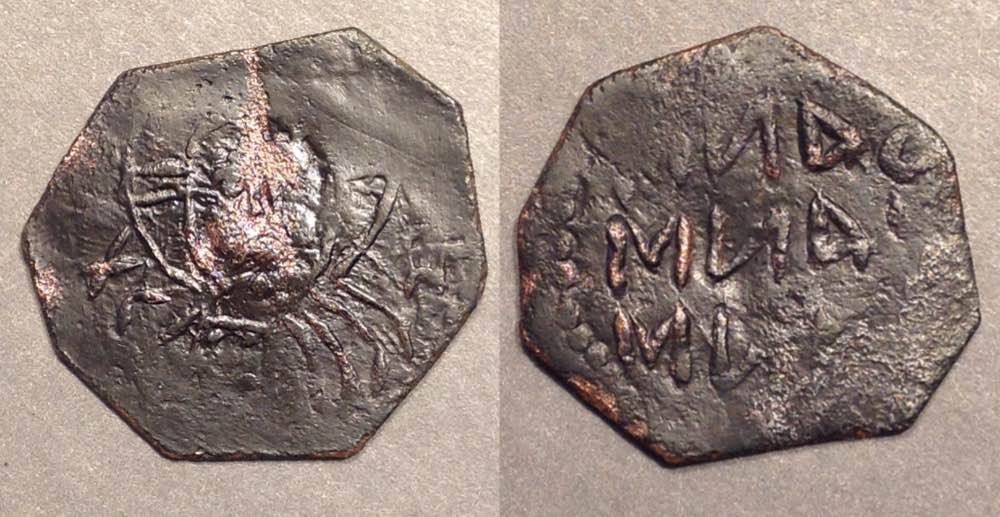 |
Amīr Ghāzī
AH 497-528
AD1104-1134
Bust of Christ. No obverse legend.
Greek inscription, sometimes with more letters (image 1) and sometimes with fewer blundered letters (image 2). Intended is:
OMEΓAC The great
AMHPAC amir
AMHPΓA Amir Gha
ZHC zi
|
Album 1237 "RRR" (but blundered examples have appeared recently)
Whelan 16.1 (1 piece)
Note: This type is much earlier than other figural types.
Images courtesy of Album 37, lot 527 and PC1.
|
SSS Dan-2. 27 mm.
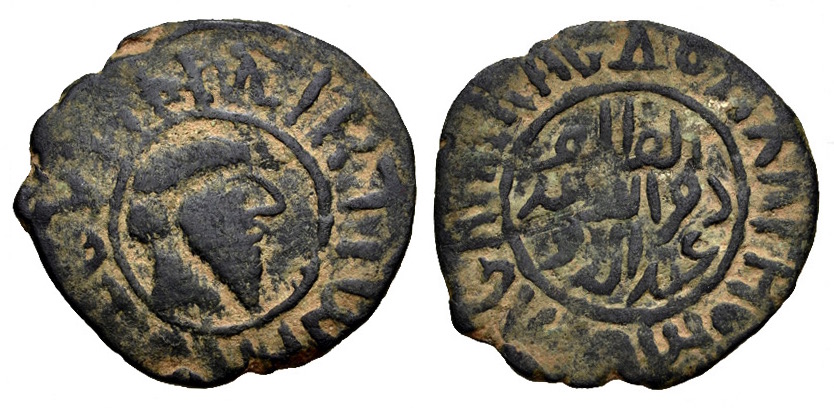 |
Dhu 'l-Qarnayn
(Dhu 'l-Qarnayn b. 'Ayn al-Dawla)
AH 547-557
AD 1152-1162
Danishmendids of Malatya
Bi-lingual
Male bust right in circle, Greek legend around:
INΔΙΚΤΙΟΝΟCΔEVTEPIC
"The second indiction"
3-line legend in circle:
al-Wathiq/Dhu 'l-Qarnayn b./'Ayn al-Dawla
Around: OMEΓACAMHPACΔOΛXAPNAI
"The great amir Dhu 'l-Qarnayn" |
Album 1240 "RR"
Whelan 16.4 (8 pieces)
Malatya mint
Wilkes 1307
Image courtesy of CNG 298, lot 434 |
SSS Dan-3. 33 mm.

|
Nasir al-Din Muhammad
(Nasir al-Din Muhammad b. Dhu 'l-Qarnayn)
AH 557 - 565; 570-573
AD 1162 - 1170; 1175 - 1178
Danishmendids of Malatya
No mint name, but probably struck in Malatya in Eastern Turkey. Dated 558 = 1158/9.
Two standing figures: Virgin crowning the emperor/
4-line legend
Obverse: Two standing figures, a close copy of the reverse of an electrum coin and a trachy of Manuel Comnenus (1143-1180/537-576), on the right the Virgin Mary with right hand raised crowing the figure on the left, the Emperor Manuel. (An Artuqid coin, S&S 29, has a similar design.) Between and above the figure’s heads is an ornamental device (probably a Danishmendid tribal tamgha) and on the right upwards
thaman khamsin ("eight fifty")
and on the left upwards
khamsmi’a (“five hundred”)
Reverse: Nasir al-din / Muhammad ibn Dhi / 'l-Qarnayn b. / ‘Ayn al-Daw(lah)
“Defender of the Faith, Muhammad ibn Dhu ’l-Qarnayn ibn ‘Ayn al-dawla” [See also DC.]
|
Album 1241.1 "R"
Whelan 16.5 (8 pieces)
BN 1953 var. (rev. legend);
Wilkes 1308
Image courtesy of CNG 81, lot 1232
|
SSS Dan-4. 28 mm.
 |
Nasir al-Din Muhammad b. Dhu 'l-Qarnayn
AH 557 - 565; 570-573
AD 1162 - 1170; 1175 - 1178
Horseman riding right slaying dragon. No obverse legend. This design might be inspired by a crusader type of Roger of Salerno.
3-line reverse legend:
(Nasir) al-Din / Abu’l-Fath / Muhammad b. Dhu ’l-Qarnayn / Nasir Amir al-Mu’minin
“Defender of the Faith, Father of Victory, Muhammad ibn Dhu ’l-Qarnayn, Supporter of the Commander of the Faithful”
[See also DC.]
|
Album 1241.2 "RR"
Wilkes 1309 (no photo)
Whelan 16.6 (6 pieces)
Image courtesy of the ANS
1917.215.840
|
SSS Dan-5. 30 mm. Second coin: 32 mm.


|
Fakhr al-Din Qasim b. Dhu 'l-Qarnayn
AH 565 - 567
AD 1170 - 1172
Lion sitting, right forepaw raised, nearly facing ("sejant"). No obverse legend.
4-line legend in circle:
Fakhr al-Din
Qasim b. Dhi
'l-Qarnayn b.
'Ayn al-Dawla
This type "defies precise association with a prototype" [Whelan, p. 150]
|
Album 1242 "RR"
Wilkes 1311 (no photo)
Mitchiner 1011
Whelan 17.7 (2 pieces)
Images courtesy of
PC1 and Savoca 168, lot 1924. |
|
SSS Dan-6. 26-28 mm.
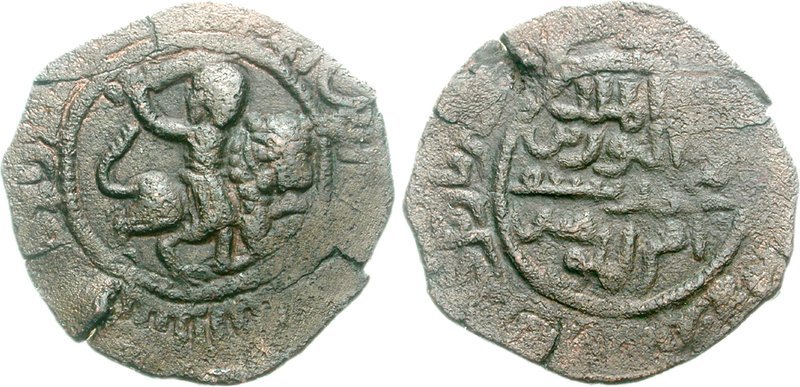
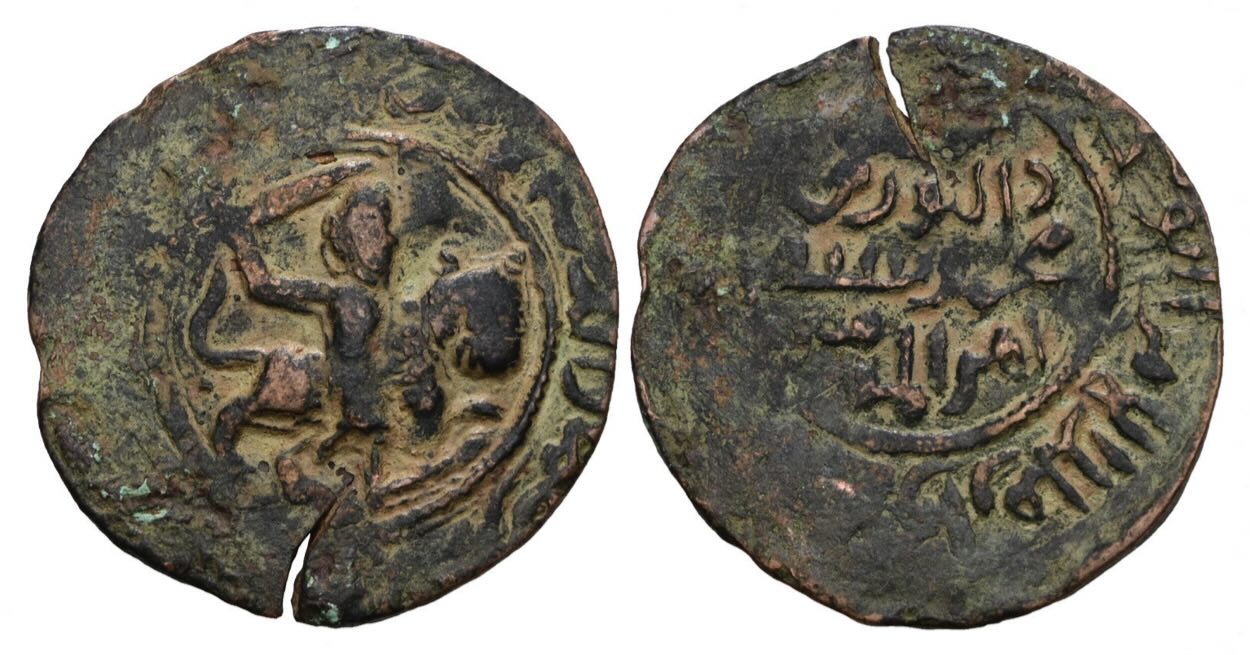
|
'Imad al-Din Dhu 'l-Nun
(b. al-Malik Muḥammad)
at Kayseri
AH 536-570
AD 1142-1175
Danishmendids of Kayseri
Man riding lion right, brandishing sword, legend around: al-Amir al-Isfahsaler al-Ajall al-/Sayyid al-Kabir 'Imad al-Din
4-line legend in circle, legend around:
Central legend: al-Malik/Dhu 'l-Nun b./Muhammad Sayf/Amir al-Mu'minin
Around: Nasr al-Islam Shirban Bik Jabuk Suwar Malik al-Umara Abu Shuja
"The lion rider wielding a sword has proved to be very difficult to trace to its origins" Whelan, p. 152
|
Album 1243 "R"
Wilkes 1302
Mitchiner 1009-10
Whelan 17.9 (16 pieces)
Images courtesy of CNG 78, lot 1931
and PC1
(28.6-27.5 mm, 6.81 grams)
|
SSS Dan-7. 31 mm.
 |
Nizam al-Din Yaghi Basan b. Amir Ghazi
AH 536 - 559
AD 1142 - 1164
Danishmendids of Sivas
Male diademed bust right in circle, legend around:
Malik Danishmend Zahir Amir al-Mu'minin
Reverse legend in three lines:
al-Malik al-'Adil/Nizam al-Din Yaghi Basa(n)/b. Malik Ghazi
"It has been impossible to find a specific model for it [the obverse bust]" (Whelan p. 157)
|
Album 1245 "R"
Whelen 17.11 (9 pieces)
Wilkes 1305
Mitchiner 1008
Whelan 17.11
Image courtesy of PC 1 |
SSS Dan-8. 29 mm. (Second coin, 27-25 mm)

 |
Shams al-Din Isma'il b. Ibrahim
AH 559 - 567
AD 1164 - 1172
Danishmendids of Sivas
Seated figure in circle, feet on the ground, legend around:
Abu 'l-Muzaffar Isma'il b. Ibrahim b
Muhammad Zahir Amir al Mu'minin
3-line reverse legend:
al-Malik al-'Alim
al-'Adil Shams
al-Dunya wa 'l-Din
"adapted from a billon type struck by Alexius Comnenus after his reform of the coinage in A.D. 1092" (Whelan, p. 159). Another possible model is the Byzantine anonymous bronze type Class D already copied by the Artuqid type S&S 2.
|
Album 1247 "RR"
Whelan 17.12 (21 pieces)
BN -;
Images courtesy of PC 1 |
Minor Turkish Dynasties: Begteginid, Begtimurid, Salduqid (Saltuqid), and Menkujakid. The entries have been extracted from of the Checklist by Stephen Album. A timeline and map is below. Types that are not figural are omitted.
A very short history of the Begteginids is below. A short history of the Begtimurids.
Minor Dynasties
Begteginid, Begtimurid, Salduqid [Saltuqid], and Menkujakid
SSS Begteginid-1. 30-28 mm.

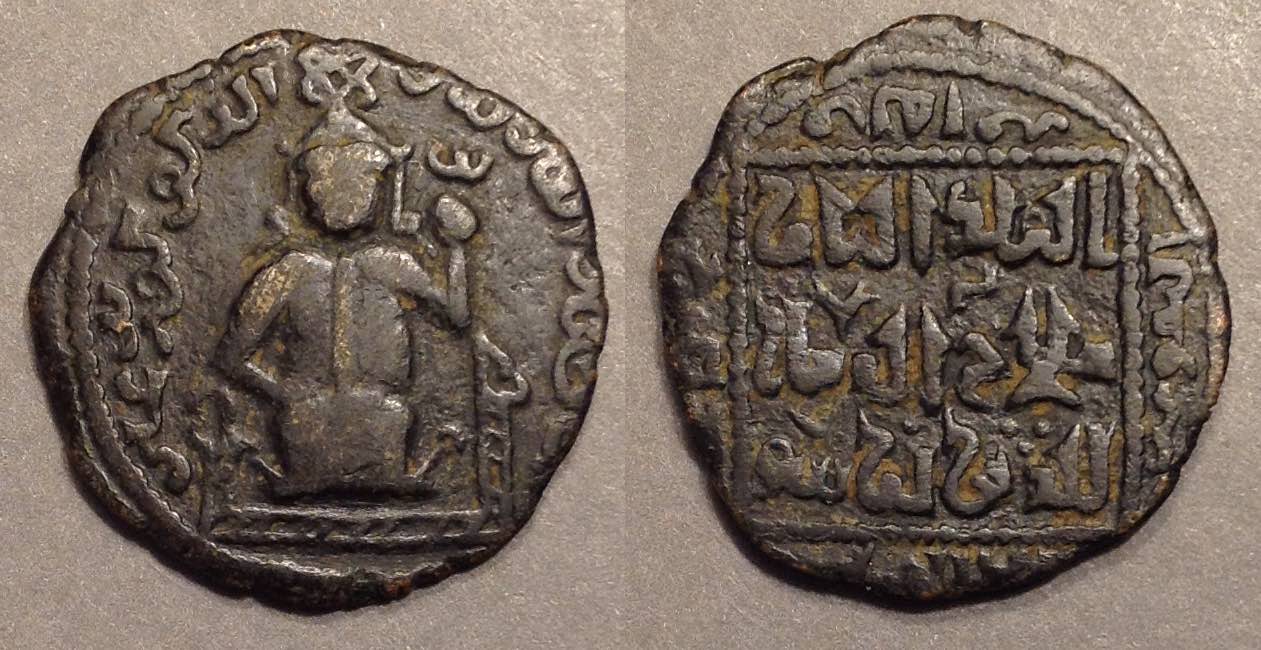 |
Begteginid (at Irbil = Erbil)
Muzaffar al-Din Kokburi [Gokburi, Gokbori]
AH 563-630
AD 1168-1233
(coins 1193-1233)
Enthroned facing figure, legend around:
Muzaffar al-Dawla wa 'l-Din Kokburi ibn Ali
3-line legend in square:
al-Malik al-Nasir Salah al-Dunya wa 'l-Din Yusuf
Legend continues outside the square.
ibn Ayyub Muhyi Dawlat Amir al-Mu'minin.
["ibn Ayyub" is Saladin].
Muhyi Dawlat Amir al-Mu'minin means "the reviver of the dynasty/state of the commander of the faithful."
There is no mint or date.
|
Album 1888.1
BN 826-36;
Images courtesy of CNG 97, lot 901
and PC1 (27.8 mm)
|
SSS Begteginid-2. 28-26 mm.
Begteginid-2.1 is bust right
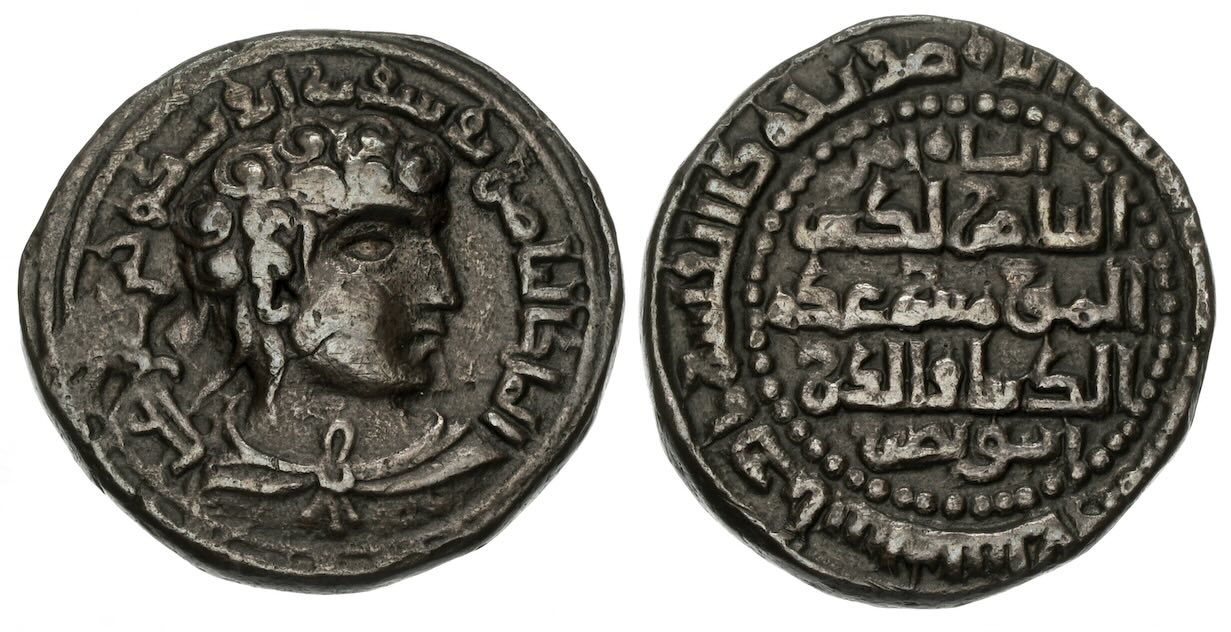
Begteginid-2.2 is bust left
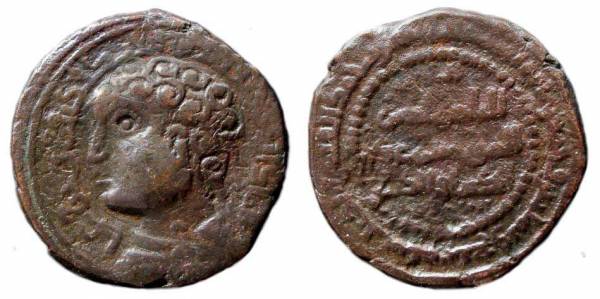 |
Begteginid (at Irbil)
Muzaffar al-Din Kokburi [Gokburi, Gokbori]
AH 563-630
AD 1168-1233
(coins 1193-1233)
Bust with curly hair [The obverse resembles S&S 11.]
/3-line legend in circle, legend around.
Inscription around: al-Malik al-Nasir Yusuf ibn Ayyub Kukburi ibn ‘Ali
“the Victorious King, Yusuf ibn Ayyub, Kukburi ibn ‘Ali”
Reverse inscription: allah / al-nasir li-din / al-mu’minin ‘uddat / al-dunya wa’l-din / amir abu nasr muhammad, within pearled circle (the second line omits the word amir from the caliph’s title)
"God / Protector of the Religion of the Faithful, Instrument of (this) World and the Faith / the Amir Abu Nasr Muhammad"
Inscription around: bism allah duriba hadha’l-fals bi-irbil sana sab‘ wa thamanin wa khams mi’a
“in the name of God this fals was struck in Irbil the year seven and eighty and five hundred”
[See also DC.] ( Bust right)
|
Album 1888.2 "RR"
Image courtesy of CNG, Islamic Auction 9, lot 465 and
Image courtesy of Stephen Album
|
SSS Begteginid-3. 28 mm. Second coin: 25 mm.

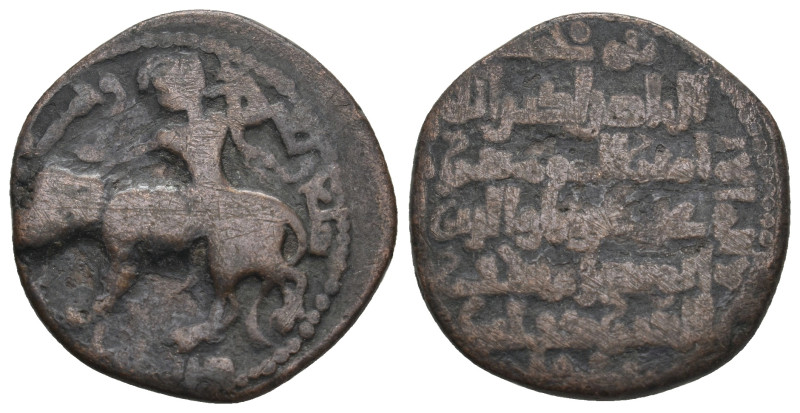
|
Begteginid (at Irbil)
Muzaffar al-Din Kokburi [Gokburi, Gokbori]
AH 563-630
AD 1168-1233
(coins 1193-1233)
Lion-rider left (or right)
[The lion-rider is similar to S&S 39, but the reverse of S&S 39 has 3 lines and legend around.]
Legend: Struck in Irbil in 597.
Reverse legend: al-Nasir li-Din Allah Amir al-Mu'minin 'Uddat al-Dunya wa 'l-Din Abu Nasr Muzaffar al-Din Kukburi. Around this, on the right, top and left, it says, beginning at the right, There is no god but God and Muhammad is the messenger of God.
al-Nasir li-Din Allah Amir al-Mu'minin is the caliph. 'Uddat al-Dunya wa 'l-Din means "instrument of this world and the next." Presumably this refers to the caliph.
|
Album 1888.3 "R"
Wilkes 1289
Mitchiner 1146-7
Images courtesy of Album 24 lot 446
and PC1.
|
SSS Begteginid-4. 22 mm.
 |
Begteginid (at Irbil)
Muzaffar al-Din Kokburi [Gokburi, Gökböri] ibn Ali/Saladin
AH 563-630
AD 1168-1233 (coins 1193-1233)
Seated figure in niche
/Hexagram star with double outline.
Legend around the seated figure: Muzaffar al-Din Kukburi.
Reverse legend within the star: al-Malik al-Nasir Salah al-Din Yusuf [his Ayyubid overlord, Saladin]
Struck in Harran in 583. The mint and date are around the outside of the star.
|
Album 1888.4 "R"
Wilkes 1290
Mitchiner 816 (w. Saladin ID)
Image courtesy of the ANS, 1917.215.944 |
SSS Begtimurid-1. 24 mm.

|
Begtimurid (at Ahlat = Akhlat)
(a.k.a. Shah-i Armanids)
Sayf al-Din Begtimur
AH 579-589
AD 1183-1193
Cow and calf [or horse and colt]
Obverse legend around: Amara bi-darbihi al-'abd al-faqir sana ithnain thamanin khams-mia.
"The Poor Slave [of God] ordered that this be struck in the year 582." [AD 1186/7]
Reverse central legend: al-Nasir li-l-Din Amir al-Mu'minin [the caliph].
Around it, top, bottom and on each side, beginning on the left side: al-Sultan al-Mu'azzam Badr al-Dunya wa 'l-Din Ghiyath Amir al-Mu'minin
"the Exalted Sultan the Moon of this World and the Helper of the Commander of the Faithful."
This coin presumably belongs to Sayf al-Din Begtimur but his name does not appear on the coin.
No mint.
This is the only Begtimurid type. Album sees horns (making it a cow) where others see ears (allowing it to be a horse). Some think it is a horse being attacked by a wolf from below. |
Album 1889 "R"
Mitchiner 1148
Image courtesy of Album 19, lot 665
|
SSS Sal-1. First example, 24.6-21.0 mm.

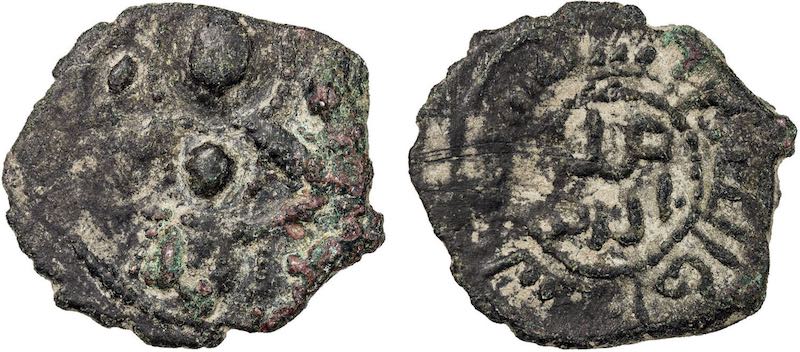
|
Salduqid [= Saltuqid] (at Erzurum)
Diyā’ al-Dīn Ghāzī
Ziya al-Din Ghazi *
AH 510-526
AD 1116-1132
The Virgin with the Christ-Child in her lap. (A Byzantine-inspired type. cf. Sear 1909 of Alexius I. )
Short legend in small circle: Diya' al-Din
Legend around: illegible but might contain the rest of his name Abu 'l-Muzaffar Ghazi or per:Album the name of his Seljuk overlord Mahmud II, that is it would say something like al-Sultan al-Muazzam Mahmud ibn Muhammad. . .. the Seljuk Sultan Mahmud II ruled 511-25/1118-31.
No mint or date.
|
Album A1890 "RRR"
* İzmirlier 05, his spelling
Images courtesy of PC1 (4.05 grams)
and Steve Album 34, lot 859 (5.38 grams)
|
SSS Sal-2.

 |
Salduqid (at Erzurum)
Diyā’ al-Dīn Ghāzī
Ziya al-Din Ghazi *
AH 510-526
AD 1116-1132
St. George slaying the dragon, crudely engraved.
Short legend in small circle, legend around
In the circle: Ziya al-Din
Around: al-Sultan mu'azzam Mugis al-Din
("citing Iraqi Seljuq Sultan Mahmud II (1120-1131) as overlord"*)
No mint or date.
|
Album C1890 or 1891 "RRR"
* İzmirlier 06, his spelling
Image courtesy of Album 30, lot 564
and PC1 (23-20 mm, 4.17 grams) |
SSS Sal-3.
 |
Salduqid (at Erzurum)
Diyā’ al-Dīn Ghāzī
Ziya al-Din Ghazi *
AH 510-526
AD 1116-1132
King standing (or enthroned?), holding spear instead of long cross.
Short legend in small circle, legend around
Inscriptions the same as SSS Sal-1
|
Album D1890 "RRR"
* İzmirlier 02, his spelling
Image courtesy of Album 34, lot 860 |
SSS Sal-4. 23 mm.
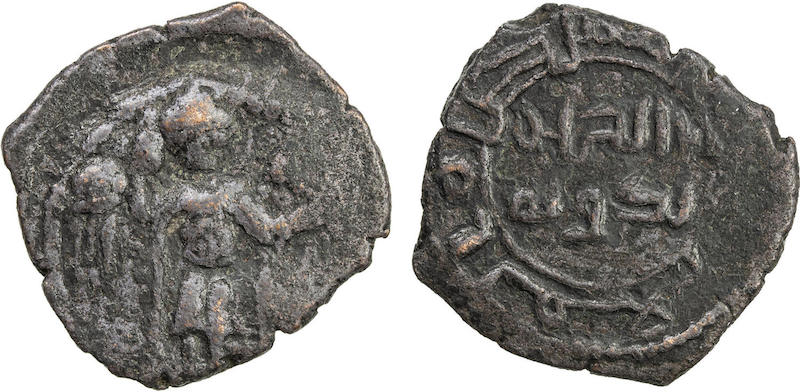
|
Salduqid (at Erzurum)
Naṣīr al-Dawla Ghāzī
Izz al-Din Salduk *
AH c. 526-540
AD c.1132-1145
Standing figure holding staff and diadem, with cornucopiae in background.
2-line legend in circle: Nasir al-Dawla.
Legend around: probably the name of his Seljuk overlord and probably says al-Sultan al-Mua'zzam Mas'ud ibn Muhammad. The word "al-Mu'azzam" is visible. This sultan ruled 529-47/1134-52.
|
Album B1890 "RR"
* İzmirlier 10, his spelling
Image courtesy of Album 37, lot 813
|
|
SSS Sal-5. 22-23 mm.
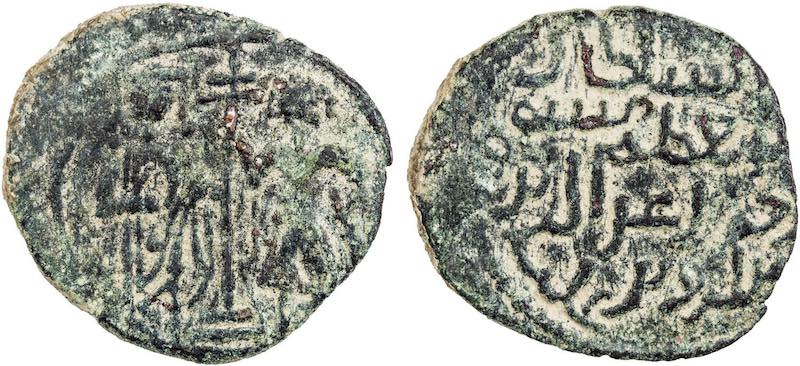
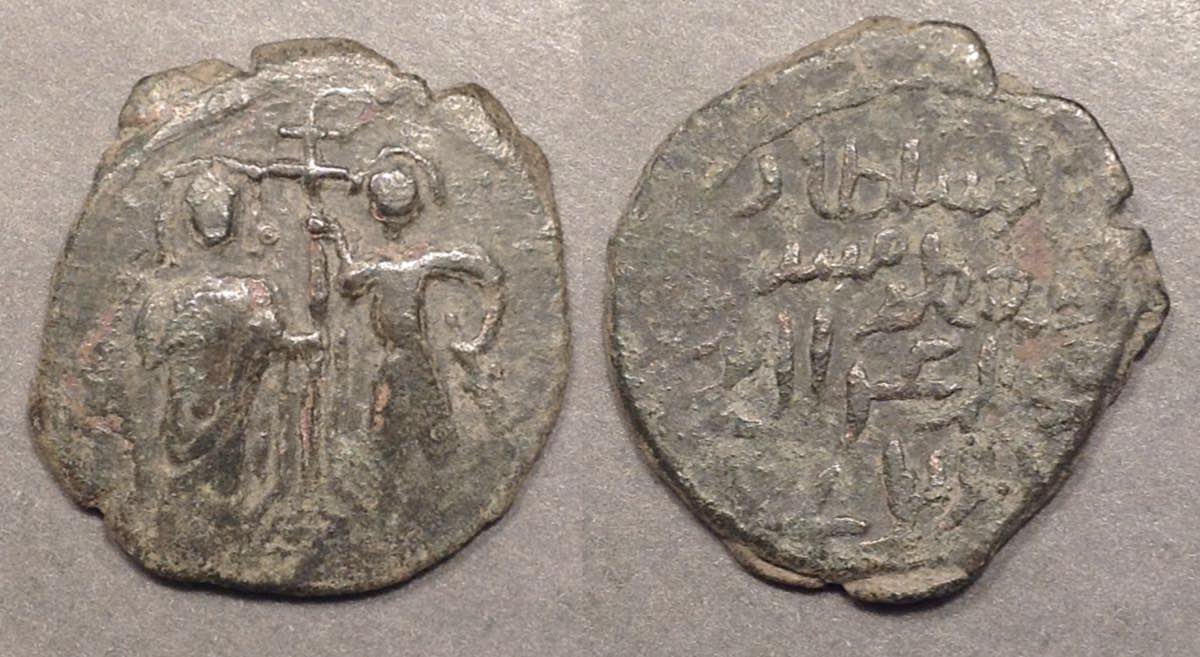
|
Salduqid (at Erzurum)
'Izz al-Din Salduq b. 'Ali
İzzeddin Saldik *
AH 523-563
AD 1129-1168
Two standing figures with cross on steps between them
4-line legend
Two standing figures with the one on the right holding a patriarchal cross on three steps in his right hand. This may be the Byzantine emperor John II Comnenus on the left and St. George on the right, but it could equally well be the Emperor Manuel I Comnenus (1143-1180/537-576) and St. Theodore on the right. Manuel was active in eastern Anatolia at this time and St. Theodore was a very popular warriorsaint in the east, frequently shown on horseback, as was St. George.
Reverse inscription: al-sultan / al-mu‘azzam mas‘ud / (ibn) muhammad ‘izz al-din / salduq ibn ‘ali
“The Mighty Sultan Mas‘ud ibn Muhammad ‘Izz al-Din Salduq ibn ‘Ali” [See also DC.]
|
Album 1890 "R"
Mitchiner 1013
* İzmirlier 16 and 17, his spelling
Images courtesy of Album 32, lot 556
and PC1
|
SSS Sal-6.

|
Salduqid (at Erzurum)
'Izz al-Din Salduq b. 'Ali
İzzeddin Salduk *
AH 523-563
AD 1129-1168
Facing half bust, nimbate, holding sword & shield [A Byzantine-inspired type]
Legend in circle: 'Izz al-Din.
Legend around: probably the name of his Seljuk overlord. This would be al-Sultan Ghiyath al-Dunya wa 'l-Din Mas'ud ibn Muhammad (529-47/1134-52). |
Album 1890B "RRR"
* İzmirlier 14-15, his spelling
Image courtesy of Album 39, lot 2571 |
|
SSS Sal-7. Second one 25 mm.


|
Salduqid (at Erzurum)
Muhammad b. Salduq
(Nāṣir al-Dīn, Qizil Arslān)
Nâsirüddin Muhammed *
AH 563-587
AD 1168-1191
Mounted archer shooting arrow at animal behind
3-line legend in circle, legend around
A mounted archer riding left, shooting back an arrow behind him at a small animal, probably a gazelle, an angel above the bow
Reverse inscription: nasir al-din kiz / il arslan muhammad / ibn salduq
“Defender of the Faith, Kizil Arslan, Muhammad ibn Salduq”
Inscription around from 2:00: al-sultan al-mu‘azzam tughrul ibn arslan
“The Mighty Sultan Tughrul ibn Arslan” [See also DC.]
|
Album 1891 "R"
Mitchiner 1014
* İzmirlier 23-24, his spelling
Images courtesy of Album 32, lot 558
and PC1.
|
SSS Men-1. 19 mm


|
Menkujakid (at Erzincan)
Fakhr al-Din Bahramshah [a.k.a. Bahram Shah]
AH c. 563-622
AD c. 1167-1225
Mint of Erzincan. Year 563 = AD 1167/8
Facing half-length Byzantine-style bust
5-line legend (in very small lettering). Another line vertically up the right side
Legend: Fakhr al-Din Bahram Shah ibn Da'ud ibn Ishaq Nasir Amir al-Mu'minin, sana thalatha wa sittin.
The last word is written perpendicular to the rest of the inscription on the right side. This is his full name and title and calls him Nasir Amir al-Mu'minin or "Defender of the Commander of the Faithful." This is Nasir with a long i rather than a long a, which is a different word. This can only be seen clearly in transliteration. The date is also given as sana thalatha wa sittin or "year 63" that is 563. |
Album 1892.1 "RR"
Images courtesy of Album 38, lot 502
and PC1
|
SSS Men-2. 23 mm and 20 mm.
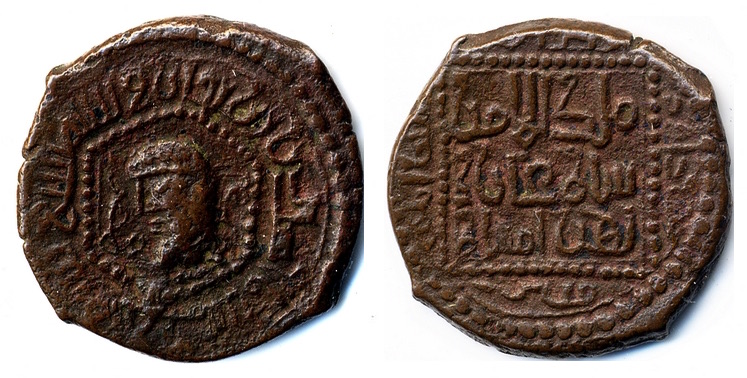
 |
Menkujakid (at Erzincan)
Fakhr al-Din Bahramshah
AH c. 563-622
AD c. 1167-1225
Head left in hexagon, legend around
3-line legend in square
The one-word inscriptions to the left and right of the bust together read Fakhr al-Din. The inscription around the bust reads "Duriba bi-Arzinjan sanat tis'a saba'in khams mi'a"" or "Struck in Erzincan in the year 579."
Legend in the square: Malik al-Umara Shah Ghazi Bahram Shah.
Malik al-Umara means "king of the amirs."
Around the square: Nasir Amir al-Mu'minin Ibn Da'ud.
The inscriptions on the lower coin seem to be the same but this coin is stylistically somewhat different. The bust has only a word on the left. And it might have a different date, which is illegible.
|
Album 1892.3 "R"
Wilkes 1296
Images courtesy of ANS
1930.168.65
and PC 1
|
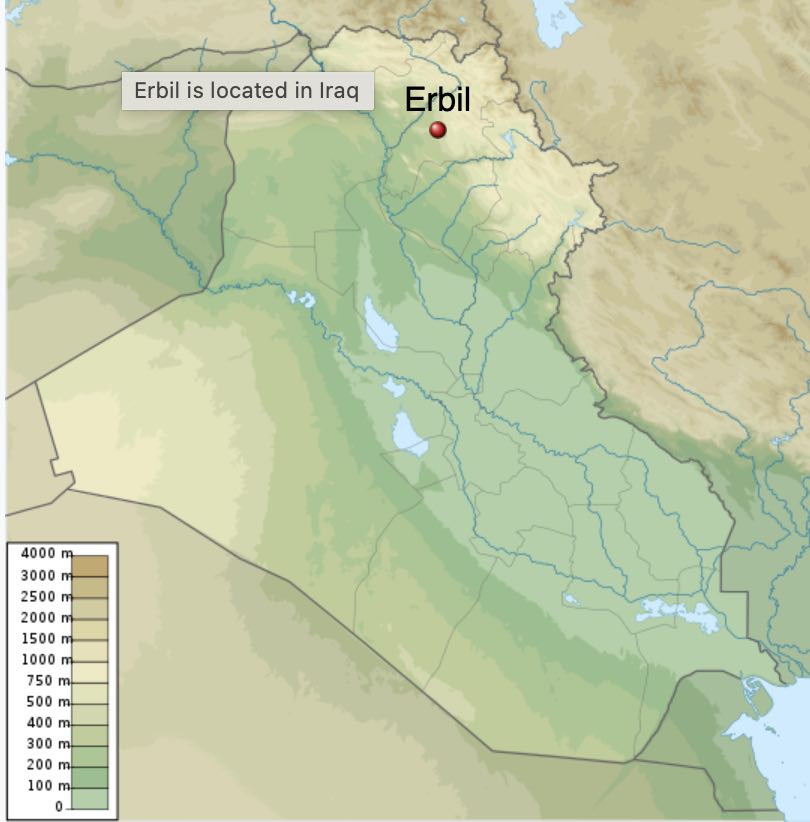 The Begtegnids issued figural coins only under Muzaffar al-Din Kokburi [Gokburi, Gokbori, Gökböri] at Erbil (= Irbil, now a big city of c. 1,600,000 people) which is east of the Tigris (i.e. "across" the Tigris) in modern northern Iraq (now Kurdish territory). His complicated story is here at wikipedia: Muzaffar al-Din Kokburi [Gokburi, Gokbori]. Originally the family was associated with the Seljuq Turks. When his father, the ruler of Erbil, died, Gokbori was in line to be ruler. However, he was only 14 years old and was expelled. He eventually took service with the Zengids of Mosul. After the Zengids (under Izz ad-Din Mas'ud, 1180-1193, who issued figural types S&S 62 and 63) lost a battle to Saladin he switched sides in 1182 and served as a general for Saladin (founder of the Ayyubids who issued types SSS Ay 1-3 above). He commanded the left wing at the decisive Battle of Hattin in 1187. Saladin let Gokbori take Erbil in 1191 and when Saladin died in 1193 he became effectively an independent ruler. He died in 1233. Presumably, his coins would be dated 1193-1233. In 1258 the last Begteginid ruler surrendered to the mongols (but only Kokburi issued figural coins).
The Begtegnids issued figural coins only under Muzaffar al-Din Kokburi [Gokburi, Gokbori, Gökböri] at Erbil (= Irbil, now a big city of c. 1,600,000 people) which is east of the Tigris (i.e. "across" the Tigris) in modern northern Iraq (now Kurdish territory). His complicated story is here at wikipedia: Muzaffar al-Din Kokburi [Gokburi, Gokbori]. Originally the family was associated with the Seljuq Turks. When his father, the ruler of Erbil, died, Gokbori was in line to be ruler. However, he was only 14 years old and was expelled. He eventually took service with the Zengids of Mosul. After the Zengids (under Izz ad-Din Mas'ud, 1180-1193, who issued figural types S&S 62 and 63) lost a battle to Saladin he switched sides in 1182 and served as a general for Saladin (founder of the Ayyubids who issued types SSS Ay 1-3 above). He commanded the left wing at the decisive Battle of Hattin in 1187. Saladin let Gokbori take Erbil in 1191 and when Saladin died in 1193 he became effectively an independent ruler. He died in 1233. Presumably, his coins would be dated 1193-1233. In 1258 the last Begteginid ruler surrendered to the mongols (but only Kokburi issued figural coins).
The Begtimurids were a short-lived minor dynasty which issued coins only under Sayf al-din Begtimur (1185-1193) and only at Ahlat (Akhlat). Ahlat is now  a city of about 30,000 people on the shores of Lake Van in Turkey, only 35 miles south of the site of the Battle of Manzikert. After the battle in 1071 the Seljuq Turks under Arp Arslan took the town which had been Armenian. The Seljuks then gave control over the town to the Turkoman slave commander Sökmen el-Kutbî (or al-Qutbi). Sökmen and his successors were known as the Shah-Armens (Kings of Armenians) (or Ahlat-Shahs) and made Ahlat their capital. They lost control to the Ayyubids (in 1207?).
a city of about 30,000 people on the shores of Lake Van in Turkey, only 35 miles south of the site of the Battle of Manzikert. After the battle in 1071 the Seljuq Turks under Arp Arslan took the town which had been Armenian. The Seljuks then gave control over the town to the Turkoman slave commander Sökmen el-Kutbî (or al-Qutbi). Sökmen and his successors were known as the Shah-Armens (Kings of Armenians) (or Ahlat-Shahs) and made Ahlat their capital. They lost control to the Ayyubids (in 1207?).
 Timeline. Map of the region in 1200 (Map from EurAtlas)
Timeline. Map of the region in 1200 (Map from EurAtlas)
Italics: Places in italics are located on the map. (Click on the map to enlarge it.)
1071 The battle of Manzikert (in eastern Turkey). The Seljuqs (Seljuks) defeated the Byzantines under emperor Romanus IV (1068-1071) and captured most of Anatolia (modern Asian Turkey). The Byzantine loss of Asia allowed Turkomans to form some regional dynasties.
1071-1202 Salduqids (Saltukids) at Erzurum in northeast Turkey.
1071-1284 dates of issue of figural bronzes of the Seljuqs of Rûm. (Rûm was the Arabic/Turkish word for Rome. Anatolia was Rome that is, the land of the Eastern Roman Empire. The gray area on the map.) The Seljuqs fought against the crusaders of the First Crusade.
1081-1118 Alexius I Comnenus, Byzantine emperor during the First Crusade.
1086-1178 Danishmendids. A dynasty established in north-central Anatolia (around Amasya [in the north of the gray area]) after civil wars of the Seljuks upon the death of the Sultan Suleyman I of Rûm in 1086.
1096 First Crusade called.
1099 Jerusalem captured by the crusaders. For many their crusade was over and they begin to go back to Europe, leaving the Holy Land critically short of soldiers.
1101 Four large armies of crusaders, maybe 20,000 people each, were, one after the other, annihilated by the Seljuqs in Turkey while on the route from Constantinople toward Antioch. Most famous is the one under Frederick Barbarossa who drowned attempting to cross a river. Leaderless, his followers broke apart and few made it through. No coins resulted.
1118-1143 John II Comnenus, Byzantine emperor.
1143-1180 Manuel I, Comnenus, Byzantine emperor.
1144-1174 reign of Fakhr al-Din Qara Arslan, the first Urtuqid (or Artuqid) to issue figural bronze, at Hasankeyf [Hisn Kayfa]. Later Urtuqids issued them at Mardin.
1167-1225 dates of issue of figural bronzes of the Menkujakids [a.k.a. Mengüjek] (founded 1071 after the Battle of Manzikert) at Erzincan.
1168-1223 Begteginids, Muzaffar al-Din Kokburi. Figural bronzes at Irbil = Erbil (Tiny letters, right center, near Mosul).
1180-1193 reign of 'Izz al-Din Mas'ud I, the first Zengid to issue figural bronzes, at Mosul. Later Zengid types were issued at Damascus [Dimashq], Aleppo, Nisibin, Sinjar [near Aleppo], Mosul (al-Mawsil), and al-Jazira.
1183-1193 Begtimurid, Sayf al-Din Begtimur, at Ahlat (near Manzikert).
1169-c.1260 Ayyubid dynasty, founded by Saladin (1169-1193) (including all the region from Egypt (in green) to and including much of the darker green region of Syria and Iraq).
1169-1193 Saladin, 1169-1193.
1187-1199 Richard the Lionheart, Crusader of the Third Crusade. He was in the Holy Land fighting against Saladin, 1191-1192.
1195-1203 Alexius III, Angelus-Comnenus, Byzantine emperor when Constantinople (upper left) fell to the Fourth Crusade.
1196-1204 Sulayman II, Seljuq ruler of Rûm.
1204 Constantinople captured by the Crusaders of the Fourth Crusade.
1204-1254 Constantinople occupied by the Latins.
1261 Constantinople restored to Byzantine control under Michael VIII.
1280-1298 Mas'ud II, the last Seljuq to issue figural bronze coins.
1291 Acre [Akko] fell (a coastal city north of Jerusalem, in the orange region). It was the last city held by the Crusaders in the Holy Land. There were no further crusades to retake Jerusalem.
Notes about inscriptions. Legends consist of names, titles, and sometimes dates and mints. Here is a page about legends with a glossary of terms commonly found on Turkoman figural bronzes.
Translation credits:
Gary Leiser: SSS Ay-2, 3, 4, 5, 6, 7, 8, 9. SSS Begteginid-1, 2, 3, 4. SSS Begtimurid-1. SSS Salduqid-1, 2, 3, 4, 6, 7. SSS Men-1, 2. All the Seljuq legends.
"DC". The David Collection Museum has additional historical information. Unfortunately to see their pages in English you must first go to the main page in English: https://www.davidmus.dk/?culture=en-us and then navigate to the page with the type described in English. (When you get there, the URL of that page in English brings up a Danish version. I have not seen any other website with that flaw.) You will need one additional clicks--on "Historical Note." (You may need to click on "EN" for "English" in the far upper right.)
SSS Ay-2. SSS Ay-3. SSS Sel-9. (search on "Ayyubid" or "Seljuq")
SSS Begteginid 2. SSS Dan-3. SSS Dan-4. (Search on "Begteginid" or "Danishmendid")
SSS Sal-5. SSS Sal-7. (Search on "Saltuqid")
Steve Album: SSS Ay-6
Danishmendid transliterations and translations are from Whelan (1980).
Acknowledgements. Steve Album was very helpful in numerous ways. He sent me his fourth edition Checklist manuscript, provided many of the images, and in numerous emails he helped me identify types to include and answered many questions. Thank you very much, Steve!
When I wanted translations of the legends, Gary Leiser stepped up and created them. He donated his fine collection of Islamic coins to Willamette University in Salem, Oregon (where quite a few are on display at the Hallie Ford Museum of Art). The translations of legends are his, unless cited otherwise. Thank you, Gary!
Comment. I am far from an expert on Turkoman figural types. I wrote this page because there is a need for a reference for the figural types not in the two volumes by Spengler and Sayles and no one else had already isolated all those types in one place. Besides, it is fun to study a subject and try to organize it for others to use and enjoy. I expect there are errors and omissions. I solicit suggestions, additional legend translations, and especially corrections. Contact me at  .
.
Reference works are οn their own page.
For Turkoman types that are in S&S, see here.
Go to the Table of Contents of this entire educational site.
 Turkoman Figural Bronze Coins:
Turkoman Figural Bronze Coins:










































 if you identify any.
if you identify any. 



































 a city of about 30,000 people on the shores of Lake Van in Turkey, only 35 miles south of the site of the Battle of Manzikert. After the battle in 1071 the Seljuq Turks under Arp Arslan took the town which had been Armenian. The Seljuks then gave control over the town to the Turkoman slave commander Sökmen el-Kutbî (or al-Qutbi). Sökmen and his successors were known as the Shah-Armens (Kings of Armenians) (or Ahlat-Shahs) and made Ahlat their capital. They lost control to the Ayyubids (in 1207?).
a city of about 30,000 people on the shores of Lake Van in Turkey, only 35 miles south of the site of the Battle of Manzikert. After the battle in 1071 the Seljuq Turks under Arp Arslan took the town which had been Armenian. The Seljuks then gave control over the town to the Turkoman slave commander Sökmen el-Kutbî (or al-Qutbi). Sökmen and his successors were known as the Shah-Armens (Kings of Armenians) (or Ahlat-Shahs) and made Ahlat their capital. They lost control to the Ayyubids (in 1207?). 
 .
.